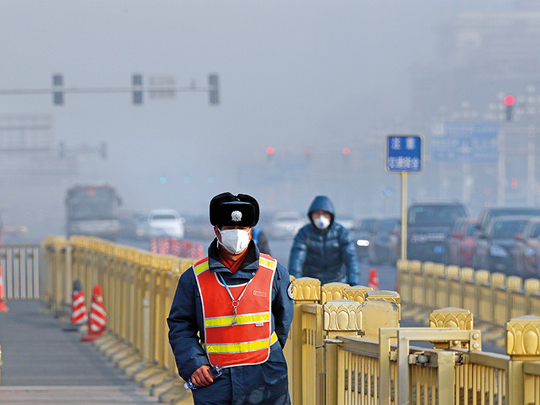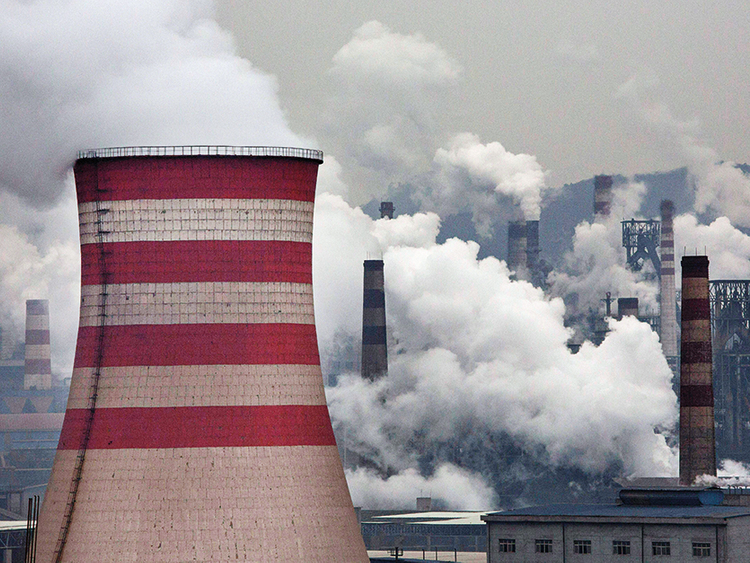
BEIJING
The great Chinese environmental cleanup, now in full swing, is shifting the corporate landscape in unexpected ways and even stoking inflationary pressure that may soon be felt in supply chains worldwide.
As President Xi Jinping’s government intensifies the fight against the country’s world-class pollution problem, companies are scrambling to adapt to tighter regulation while investing in cleaner energy. In industries from steel to textiles and consumer goods, the resulting shakeout has left the survivors with far more pricing power. That in turn is reinforcing the already-resurgent factory prices that contribute to global inflation.
These trends are reshaping the business environment, according to Cui Li, Hong Kong-based head of macro research at CCB International Holdings Ltd.
“The environment clean-up is and will be a key driver of the industrial consolidation,” said Cui, who expects to see greater concentration in steel, paper-making and pharmaceuticals. “With costs rising from wages, land and pollution curbs, China’s manufacturers will have to invest and upgrade to survive. Those who survive will benefit.”
Take He Wenyong, manager of a mid-sized textile company that has supplied Walt Disney Co. and its licence holders. Amid a forced switch to natural gas from coal in his industry, the company, Shenzhen Yabi Textiles Co., is benefiting from past investments and eating up the market share of smaller competitors that couldn’t foot the bill.
Speaking at Guangzhou’s massive trade fair earlier this month, He said his company is now able to raise prices by 8 per cent. “Those small, messy factories took up a third of market share,” said He, at a booth at the fair filled with merchandise such as beach towels inspired by the Frozen film franchise. “Now that they’re gone, everything is much better for us.”
Bigger companies, like luggage-maker Samsonite International SA, report that cost pressures arising from environmental curbs in China affect all competitors. Scale, though, helps, according to Ramesh Tainwala, the company’s chief executive officer.
“Greater competition for skilled labour and the resultant rise in factory wages are also causing significant cost pressure,” he said in an interview. “While we’ve seen a number of factories closing down, the closures generally involve smaller factories that lack the scale and resources to meet the more stringent environmental controls.”
The shake-up began in heavy industries in 2016 as the government shuttered outdated or illegal steel mills, coal mines and aluminium smelters in a shock therapy strategy to reduce excessive capacity and curb pollution. Such measures powered a more than 20 per cent jump in global metal prices from the start of the year, and led to consolidation in the nation’s sprawling steel industry.
Amid the changes, even the nation’s top aluminium producer, China Hongqiao Group Ltd. has been considering whether to relocate shuttered plants to other countries, with Indonesia top of the list of possibilities, Bloomberg News reported last week. Hongqiao, also the world’s biggest smelter, has been forced this year to cut capacity as part of Xi’s drive to curb oversupply and reduce pollution.
Now downstream, consumer-facing manufacturers are feeling the pressure. On top of cutting the electricity supply of small and polluting workshops, China’s cabinet announced a ban on the import of waste materials such as plastic, textiles and unsorted waste paper in July, to battle “serious damage to the environment.” Prices of plastic and paper surged, as making them from scratch — by drilling oil and cutting down trees — is much more expensive than recycling imported refuse materials.
What was seen as a bane of manufacturing is now emerging as an unexpected boon for the fittest that have survived. Investors are taking notice: Shares of China’s top three paper-product manufacturers — Nine Dragons Paper Holdings Ltd., Lee & Man Paper Manufacturing Ltd. and Shandong Chenming Paper Holdings Ltd. — have made stellar gains in the past year.
Factories still left standing are passing on price increases to customers. The changed dynamic was evident at the Canton Fair in Guangzhou, which is billed as the world’s largest trade gathering, bringing together more than 25,000 exhibitors and 191,000 buyers. This year, foreign buyers noted significantly higher prices, and suppliers less willing to bargain.
Suitcase manufacturer Anhui Technology Imports and Exports Co. has hiked the price of its colourful hard luggage by almost 10 per cent after the type of plastic used to make hard-shell suitcases surged 80 per cent in August and September, according to Ren Yuyang, a salesman of the company attending the fair.
“At first, customers couldn’t accept such a jump,” Ren said, calling the increase “terrifying” because luggage makers like his typically have a 3 per cent to 5 per cent margin. “But now they have to bear with it because every supplier lifts their prices.”
Argentine buyer Roxana Fernandez, who works for activity-clothing retailer Montagne Outdoors which has branches across the South American nation, said that she and her colleagues were taken aback by price rises of 20 per cent to 30 per cent at this year’s fair.
“They all said it’s because of the environmental policy, and there’s nothing they can do,” she said. “For us, we have to re-evaluate how much of our supply comes from China.”
The extent of such increases varies among sectors. Low-end makers of socks, shoes and garments at the fair said they’re not powerful enough to pass on the cost increases fully.
What’s clear is that China’s factory-gate inflation will eventually reach consumers around the world through global supply chains. The domestic producer price index leads price changes for export goods, with a lag of a few months. Producer prices rose 6.5 per cent in the first 10 months of 2017 over the same period a year earlier.
In the long run, rising supply prices will likely accelerate global buyers’ shift away from China in some categories like apparel, while raising retailers’ buying costs in others such as toys where there’s no quality alternative outside of China, said Lim Lian Hoon, Hong Kong-based managing director of consultancy AlixPartners.
Big buyers like Wal-Mart Stores Inc., Target Corp. and Disney also have sophisticated sourcing operations and have already diversified significantly to other countries for cost savings.
“The closures have only had a very limited impact on Samsonite since we generally work with much bigger, well established suppliers,” Samsonite’s Tainwala said.
Yabi Textiles’s He has also considered moving to other countries. Pakistan, with its low costs and geographic closeness to Europe, is attractive. “There are only two ways for China’s labour-intensive sectors: going up or going out,” said Zhu Haibin, chief China economist at JPMorgan Chase & Co. in Hong Kong.
—Bloomberg













